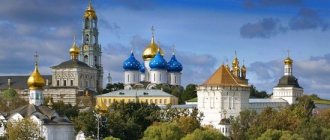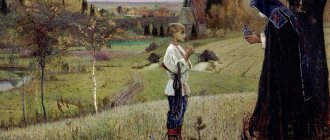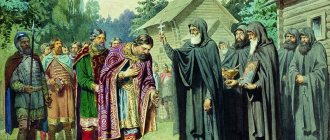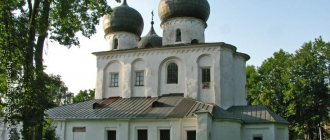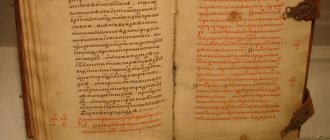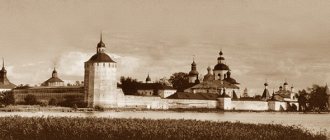St. Sergius of Radonezh is one of the most revered and beloved saints by the Russian people. The icon of this great righteous man can be found in many modern churches. The elder became famous as a miracle worker, a prophet, a true champion of the Orthodox Church. He also contributed to the development of the Russian state and the arrangement of monastic monasteries. Sergius of Radonezh is considered an outstanding historical figure, a person thanks to whom the Russian people were able to acquire the gift of true faith, learn its deep meaning and believe in their salvation in Christ.
Biography and memorial days of the saint
Before taking monastic vows, the righteous man bore the name Bartholomew. Information about him is contained in the life written by Epiphanius the Wise in 1417–1418, as well as in the works of the Athonite hieromonk Pachomius the Serb. One of the greatest Russian saints was born in 1322. His parents, Rostov boyars, became poor over time, and the family moved to live in Radonezh.
Already as a child, Bartholomew decided to devote himself completely to God. An example for him was his father and mother and older brother, who accepted monasticism. Having matured, he went to Khotkovo, where, after tonsure, he received the monastic name Sergius.
In 1337, the Trinity-Sergius Monastery was founded, in which the saint became abbot. Here Sergius of Radonezh worked along with the other monks, strictly observed all fasts, and tirelessly pacified his flesh. In addition to the Trinity-Sergius Monastery, Sergius founded the Annunciation Monastery on Kirzhach, St. George's Monastery on Klyazma and others. His devoted students became their abbots.
The monk advocated strictness in monasticism. He forbade monks to own private property and called for them to give everything they had for the use of the brethren. This saint became the initiator of the communal structure of monasteries, which was followed by many monasteries on Russian soil.
During his life, Sergius of Radonezh performed many miracles. The elder became famous for his healings, prophecies and resurrections. It was he who blessed the Moscow Prince Dmitry Donskoy to carry out the Battle of Kulikovo, which contributed to the overthrow of the Golden Horde yoke in Rus'.
In his old age, an unforgettable event happened to the monk. One day, the Mother of God herself appeared to the righteous man and promised her protection. This incident is depicted on one of his icons.
The saint lived to a ripe old age. Being spiritually illuminated, he knew in advance the time of his death. Sergius of Radonezh died on September 25, 1392. After he left this world, amazing miracles and healings began to occur at his tomb.
Sergius of Radonezh was canonized very quickly - during the lifetime of people who knew him personally. Such a case is considered very rare in Orthodoxy. In 1422 the incorruptible relics of the saint were found. They are located in Sergiev Posad, in the Trinity Cathedral of the Trinity-Sergius Lavra.
The days of remembrance of the outstanding ascetic are June 5 (Cathedral of Rostov-Yaroslavl Saints), July 6 (Cathedral of Vladimir Saints), July 18 (Discovery of Relics), July 19 (Cathedral of Radonezh Saints), October 8 (Repose of God).
A little about the icon and relics of Sergius of Radonezh (Trinity-Sergius Lavra)
One amazing case is known regarding the discovery of relics. When the saint died, construction of a new church began at the monastery. And when this process was in full swing, one parishioner saw Sergius himself. The Christian reported this in the temple and said that the saint was asking to remove his body from the water and earth.
The monks did not ignore the saint’s request. And when the coffin was lifted up, it turned out that there was indeed water in it. But what most impressed everyone around was that despite the fact that the holy elder died thirty years ago, his body and clothes were preserved in completely original form.
Subsequently, pilgrims from all over the globe began to come here to touch and see this amazing shrine with their own eyes. For some, the relics of Sergius provided physical assistance, and for others, spiritual assistance.
Other faces with the relics of the saint can be seen in a large number of Moscow churches.
Development of iconography
The iconography of the saint is based on his biography. It is quite numerous and varied. Images of Sergius of Radonezh are found in icon painting and in temple paintings (photos of images of the righteous man):
The first icon of the miracle worker was painted shortly after his death. It was created in 1392.
After the discovery of the relics of the Saint, an embroidered tombstone cover (shroud) was made. It accurately reproduced the individual features of the saint’s appearance and became the basis for all subsequent images. Today the shroud is kept in the State Historical and Art Museum-Reserve of Sergiev Posad.
At the beginning of the 15th century, the icon “The Mother of God with the Child, the Archangel Gabriel and St. Sergius of Radonezh standing in prayer” was created. It became one of the most outstanding images of the saint in Russian icon painting.
In subsequent years, hagiographic icons of the miracle worker became widespread. Such paintings not only have a historical basis, but also carry an edifying meaning. The interpretation of the scenes depicted on them allows us to extract the deepest meaning and teaches believers to follow the lifetime principles of the great righteous man.
One of the best hagiographic icons of St. Sergius of Radonezh is considered to be a painting created by the master Theodosius in 1510. On it the saint is depicted in the center, in the ark. Around his figure there are reduced fragments showing the main episodes from the life of the prayer book. The number of such scenes in hagiographic images can vary from 9 to 36.
In the 17th century, the elder began to be depicted differently - with elongated proportions of the figure. At the beginning of the 20th century, the icon “The Council of All Saints Who Shined in the Land of Russia” was created, where Sergius of Radonezh was depicted among his students and followers. Its author was the nun Juliana, who took part in the restoration of the Trinity-Sergius Lavra. There are paired icons in which the saint is depicted with his spiritual heirs, who lived several centuries after him. One of the most famous is the painting where he appears together with Seraphim of Sarov. It is known that this holy elder treated Sergius of Radonezh with special respect and bequeathed to put his enamel image in his coffin.
LiveInternetLiveInternet
In July 2014, the 700th anniversary of the birth of St. Sergius of Radonezh, whose name is familiar to most Russians, was celebrated. Sergius is revered by the Russian Orthodox Church as a saint and is considered the greatest ascetic of the Russian land. This is an exceptionally bright historical figure, and it is not surprising that many artists have turned and are turning to his image.
Probably the most famous works dedicated to Sergius belong to the artist Mikhail Vasilyevich Nesterov. During his long creative life, he created a series of works dedicated to the life and deeds of the saint. The artist himself spoke about this: “I did not write and did not want to write history in paint. I wrote the life of a good Russian man of the 14th century, sensitive to nature and its beauty, who loved his homeland in his own way and strived for truth in his own way. “I pass on the legend composed in ancient years by my native people about the people whom they marked with love and memory.” The first work of the cycle was the painting “The Vision of the Youth Bartholomew,” painted in 1889-1890.
M. V. Nesterov. "Vision of the Youth Bartholomew"
The plot of the picture is based on the “Life of St. Sergius,” compiled by Sergius’s disciple Epiphanius the Wise. At the age of seven, the youth Bartholomew (as Sergius was called in the world) was sent to study with two brothers - Stefan and Peter. The brothers studied successfully, but Bartholomew was not given a diploma. One day, while looking for missing horses in the field, he saw an unfamiliar old monk under an oak tree. The monk prayed. The youth approached him and told him his grief. Having listened sympathetically to the boy, the elder began to pray for his enlightenment. Then, taking out the reliquary, he took out a small piece of prosphora and, blessing Bartholomew with it, said: “Take, child, and eat: this is given to you as a sign of the grace of God and the understanding of the Holy Scriptures.” Grace truly descended on the boy: the Lord gave him memory and understanding, and he began to easily assimilate book wisdom. (You can read more about this painting here).
This was followed by the painting “The Youth of St. Sergius” (1892-1897). Here we have before us the already matured Sergius, who has experienced the first difficulties of a hermit’s life. After the death of his parents, Bartholomew, together with his brother Stefan, retired to live in the wilderness in the forest (12 versts from Radonezh). First they built a cell, and then a small church, and, with the blessing of Metropolitan Theognostus, it was consecrated in the Name of the Holy Trinity. But Stefan could not stand the difficulties of living in a deserted place and went to one of the Moscow monasteries. Sergius was left alone. One day a hungry bear came to the saint’s hut. The monk realized that the beast was hungry and brought him a piece of bread. Having eaten the treat, the bear retreated into the forest, but from then on it often began to come to the saint’s cell. And the Reverend thanked God for sending him a fierce beast for consolation.
The figure of Sergius of Radonezh is depicted on a low forest hillock, against the backdrop of a wooden chapel, among birds and animals.
The artist and art critic A. N. Benois (1870–1960) called this landscape “a whole poem of the northern forest.”
M. V. Nesterov. "The Youth of St. Sergius"
In 1337, Bartholomew took monastic vows with the name of the holy martyr Sergius. Gradually he became known to other monks. The Monk Sergius received everyone with love, and soon a brotherhood of twelve monks was formed in the small monastery. Their experienced spiritual mentor was distinguished by his rare diligence. With his own hands he built several cells, carried water, chopped wood, baked bread, sewed clothes, prepared food for the brethren, and humbly performed other work. St. Sergius combined hard work with prayer, vigil and fasting. This is exactly how we see the saint in the triptych “The Works of St. Sergius” (1897).
M. V. Nesterov. Triptych "Works of St. Sergius", central part
M. V. Nesterov. Triptych "Works of St. Sergius", left and right parts
The work “Reverend Sergius of Radonezh” (1899) completes Nesterov’s “Sergius Cycle”.
M. V. Nesterov. "Reverend Sergius of Radonezh"
In 1881, Viktor Mikhailovich Vasnetsov created the icon “Sergius of Radonezh” for the church in Abramtsevo, built according to the design of Polenov and Vasnetsov himself. Here Sergius is depicted as a stern peasant with work-worn hands.
V. M. Vasnetsov. "Sergius of Radonezh"
In 1895, Vasnetsov painted another picture dedicated to Sergius of Radonezh. Here is a miracle with a source. One day the monastery ran out of water. Then Sergius found a place, baptized it with a cross and began to pray to the Lord for water to appear. And a miracle happened - a spring began to flow in this place.
V. M. Vasnetsov. "Reverend Sergius of Radonezh"
The saint occupied a special place in the works of Nicholas Roerich. In 1925, Roerich created the work “Sergius the Builder”. There are two paintings with this title. Both paintings with this title depict Sergius in his labors and a bear with him. “Let my painting “Sergius the Builder” remind of indestructible construction. Sergius is a hard worker, one of the founders of Russian cultural construction.” (N.K. Roerich. Indestructible)
N.K. Roerich. "Sergius the Builder"
In 1932, the painting “St. Sergius of Radonezh” was painted. “In the foreground of the picture is Saint Sergius of Radonezh, builder of churches and monasteries, bearer of the faith of Christ, peacemaker, clairvoyant, unconditional spiritual leader of Rus' in the 14th century. With his feet he stands on the Russian Land and at the same time, as it were, rises above it. Above everyone. Dressed in purple and blue monastic robes - the colors of the highest cosmic vibrations, denoting the highest spirituality. In his palms he holds a church - the Nerl Cathedral, the most ancient temple in Russia. The Nerl Cathedral personifies Russia itself. Therefore, the image of the towering Sergius holding the Nerl Cathedral can be understood as follows: Saint Sergius is the greatest patron of the Russian Land. This was especially evident at critical moments in history. This is also evidenced by the helmets and spears of the soldiers leaving for the Kulikovo field, and the stormy sky, foreshadowing the approach of a severe battle. Three circles on a white and blue board, denoting the unity of the past, present and future, imply: this was, is and will be a defense. The sign of the All-Seeing Eye, the Eye of Revelation in a violet triangle above the head of the saint in the anxious sky - a sign of the Divine Mind, a symbolic image of God - testifies that St. Sergius is carrying out his mission according to the Higher Will.” (Marchikhin S. Painting by N.K. Roerich “St. Sergius”)
N.K. Roerich. "St. Sergius of Radonezh"
The first biography of St. Sergius Epiphanius the Wise wrote that before the battle with Mamai, Grand Duke Dmitry Ioannovich, later known as Dmitry Donskoy, met with St. Sergius and received a blessing from him. Historians argue whether this meeting took place before the Battle of Kulikovo or an earlier battle on the Vozha River, but the plot exists and the artists could not ignore it.
Alexey Danilovich Kivshenko. “Reverend Sergius of Radonezh blesses the Moscow prince Dmitry Ivanovich for the battle with Mamai.” 1874
Alexander Nikanorovich Novoskoltsev.
And modern artists are inspired by the personality of St. Sergius. Sergei Nikolaevich Efoshkin dedicated a series of works to Sergius of Radonezh.
S. N. Efoshkin. “Reverend Sergius of Radonezh. Blessing of the Prince of Moscow Dimitri Ioannovich and his squad for the battle. 1380" 1994
S. N. Efoshkin. “Reverend Sergius of Radonezh. Appearance of the Blessed Virgin Mary" 1998
S. N. Efoshkin “Reverend Sergius of Radonezh. Across Rus'" 1998
The painting by Natalya Klimova tells about the miracle of the resurrection of a youth. The father carried his seriously ill son to Saint Sergius so that he would heal the child. But on the way the boy died. Then, leaving the body in the saint’s cell, the father went away in tears to get the coffin. Sergius began to pray to God for the boy, and then the boy opened his eyes and began to move. The artist depicted the moment of the father’s return, not yet knowing that his son was alive.
Natalya Klimova. “Resurrection of a boy by St. Sergius of Radonezh”
Vasily Nesterenko. "Hegumen of the Russian Land"
Yuri Raksha. “Blessing of Dmitry by Sergius of Radonezh”, left part of the triptych
https://ru.wikipedia.org
Yarovskaya N. (Roerich E.I.). Banner of St. Sergius of Radonezh
Sayetgalieva L.V. “The Image of the Reverend in Russian Painting”
https://gallery.facets.ru/
Series of messages “Christian saints in painting”:
Part 1 - Christian saints in painting. Saint Cecilia. Part 2 - Christian saints in painting. Saint Veronica. ... Part 4 - Christian saints in painting. Saint Barbara. Part 5 - Christian saints in painting. Saint Mary Magdalene. Part 6 - Christian saints in painting. Venerable Sergius of Radonezh. Part 7 - Christian saints in painting. Saint Bavo. Part 8 - Christian saints in painting. Saint Roch. Part 9 - Christian saints in painting. Saint Jerome.
Description of the shrine
Sergius of Radonezh is depicted on icons in full growth or waist-length. On most of the religious paintings, at the level of his shoulder there is an inscription in Church Slavonic letters, which indicates the name of the saint in monasticism.
Features by which it is easy to recognize the venerable elder:
- thin face with a long beard and mustache;
- thick gray hair combed back;
- a direct, serious look (sometimes the saint looks to the side);
- strict monastic vestments (black or red cassock, stole).
The right hand of a righteous man most often depicts the gesture with which he blesses Christian believers. In the left, the saint of God holds an open scroll with sacred writings.
On hagiographic icons, the figure of the saint is surrounded by marks, each of which contains a specific plot. These most often are:
- birth of Bartholomew;
- literacy training;
- monastic tonsure;
- ordination to religious rank;
- various lifetime miracles;
- appearance of the Mother of God to Sergius;
- repose and burial of the saint;
- healing at the tomb of the Reverend;
- acquisition of honest relics.
On one of the most common hagiographic icons, called “The Appearance of the Most Holy Theotokos to St. Sergius,” the righteous man is depicted kneeling. Like the abbess, the Most Pure Virgin Mary leans on a staff. The Mother of God touches the prayer book with her hand or points to it. Behind Her are seen the apostles Peter and John talking with each other.
According to the Life, this miraculous event took place in the entryway. Micah, a student of Sergius, also witnessed the amazing incident. In religious paintings he is depicted covering his face in fear and awe of the greatness of the Queen of Heaven.
Types of images of the monk
The earthly life of the saint was very eventful. Various events from the life of the saint became subjects for iconography. Therefore, there are many icons with various images of St. Sergius. Among them:
- Half-length image with an open paper scroll.
- Half-length image with a blessing gesture and a rolled scroll.
- Life icon (in the center there is an image of a saint, around there are drawings reflecting events from the life of the saint).
- Appearance of the Heavenly Queen to St. Sergius.
- Finding the relics of a saint.
This list is non-exhaustive. In addition, there are a number of paintings that are not icons depicting the saint. They can be used to decorate your home, but you cannot pray in front of them. Therefore, before purchasing an icon, make sure that the image on it is canonical, so as not to unwittingly commit a sin.
What power does an icon have?
When turning to the face of St. Sergius of Radonezh, one manages to find a way out of the most difficult situations. The image of the holy elder helps:
- fight various sins. These include pride, lack of patience or mercy, laziness, cowardice, despondency;
- protect the weak, slandered, deceived. The righteous comes to the aid of all who suffer unjustly, patronizes widows, children, orphans;
- be healed from any illness. The icon gives hope for getting rid of visual impairments, oncology, heart diseases, joints and many other pathologies;
- achieve success in various fields of activity. Prayers in front of the shrine contribute to the absence of difficulties at work, good luck in the desire to earn an honest living;
- find missing people. There are many stories about how, after turning to the face of the righteous, missing adults or children were found;
- gain courage, strengthen your spirit in the face of the possibility of an attack, a threat to life. The saint helps prevent attacks from aggressive people and the invasion of enemies;
- get rid of the negative influence of dark forces. Those praying in front of the icon of Sergius of Radonezh receive the strongest protection from demonic influence, witchcraft, the evil eye and other manifestations of evil.
A story has been preserved about how, at the age of a youth, the monk did not keep up with his studies and could not successfully master reading and writing. One day, fate brought him together with a mysterious monk, whose name remained unknown. After a conversation with him and joint prayer, the future saint began to quickly master any science. That is why it is believed that prayers at the icon of Sergius of Radonezh help to acquire knowledge, achieve good results in learning, and allow you to direct even the most obstinate children on the right path.
The great saint of God has long been considered the patron saint of all representatives of the stronger sex who bear the name Sergei. That is why such people should definitely hang an icon in their home or wear a body image consecrated in an Orthodox church.
How to Have a Spiritual Conversation with a Reverend
You should contact Sergius of Radonezh with your existing requests as if he were alive. To be heard, you must have a pure heart, deep respect for the holy elder and deep faith in the Lord.
In most cases, they pray in front of the icon of the Pious One while standing or kneeling. There is nothing wrong if a person is tired and remains in a sitting position during prayer. During a period of illness, it is not forbidden to talk with a righteous person while lying down.
When offering prayers to Sergius of Radonezh, they often adhere to sacred texts from the Prayer Book. You can also address the monk with your own phrases. It is not necessary to pray for a long time, for several hours. The conversation with the miracle worker can be brief, either out loud or silently. It is important that it is filled with inner purity, focused on spiritual values, and comes from a person with a bright essence and good intentions.
The icon of Sergius of Radonezh, along with particles of his relics, is periodically delivered to different cities of Russia. In July 2021, the holy image visited Saransk, the capital of Mordovia, where it was greeted with joy and reverence by a huge number of Orthodox Christians.
Historical information about the icon of Sergius of Radonezh
In Russian Orthodoxy, Sergei of Radonezh is a very respected and revered saint. The life of St. Sergius occurred in the fourteenth century; the saint completely devoted it to the service of God. His life was pious, observing all the Biblical commandments.
Fasting was very important for Sergius of Radonezh; he also monitored the fulfillment of God's commandments, setting an example for other believers with his life. The saint considered laziness to be the most terrible vice, so he worked hard until old age. He also showed kindness towards all people and tried, if possible, to help everyone who needed it.
In his early years, Sergius of Radonezh once went alone into the forest. Far from city life and people, he built himself a house in which he lived for a long time, fervently praying to the Creator every day. In his prayers, Sergius asked the Lord to help protect the Russian lands and support the Russian people.
The saint was more than once offered to work in the Russian metropolitanate, but he showed contempt for political life. He preferred to lead a purely solitary life, engaged exclusively in serving the Lord.
During his life, the monk was able to provide his help to a huge number of people, awakened in them faith in God and provided his support during a difficult period of time. His such strong devotion to the Creator and unshakable faith ensured him the love of Orthodox Christians and the respect of the church. Therefore, posthumously Sergius of Radonezh was awarded the title of saint.
